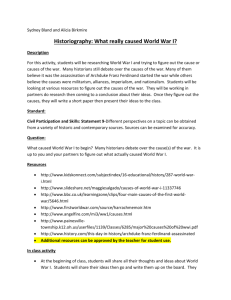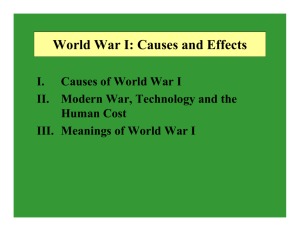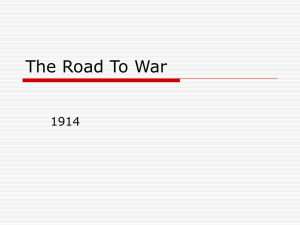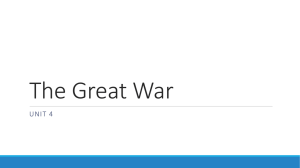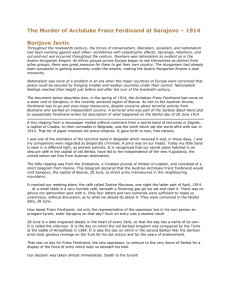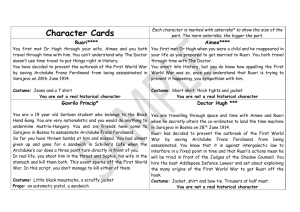History
advertisement
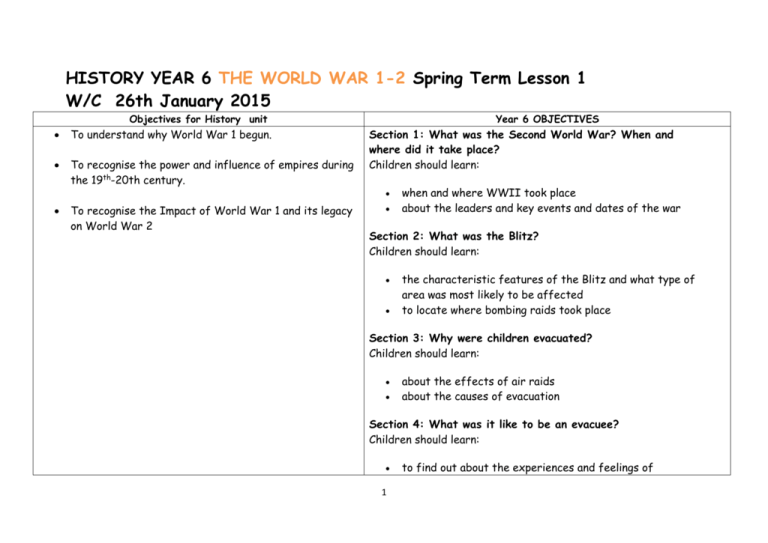
HISTORY YEAR 6 THE WORLD WAR 1-2 Spring Term Lesson 1 W/C 26th January 2015 Objectives for History unit To understand why World War 1 begun. To recognise the power and influence of empires during the 19th-20th century. Year 6 OBJECTIVES Section 1: What was the Second World War? When and where did it take place? Children should learn: To recognise the Impact of World War 1 and its legacy on World War 2 when and where WWII took place about the leaders and key events and dates of the war Section 2: What was the Blitz? Children should learn: the characteristic features of the Blitz and what type of area was most likely to be affected to locate where bombing raids took place Section 3: Why were children evacuated? Children should learn: about the effects of air raids about the causes of evacuation Section 4: What was it like to be an evacuee? Children should learn: 1 to find out about the experiences and feelings of evacuees, from a wide range of information sources to communicate their learning in an organised and structured way, using appropriate terminology Section 5: What did people eat during the war? Children should learn: Year 6 New Curriculum History British History (taught chronologically) - The changing power of monarchs - Significant turning points in British history - Crime & punishment - Leisure Broader History Study -European society, i.e. - Islamic civilization, including Baghdad - Mayan civilization - Benin (West Africa) 2 why rationing was necessary about the impact of rationing on the way of life of people living in Britain during WWII EXPECTATIONS Some children will not have made so much progress. They will be able to: describe what happened during evacuation and begin to recognise that it had causes; use sources of information to make simple observations about the war Children Achieving: YEAR GROUP/TERM: 6 ICT LINKS Research Most children will be able to: demonstrate factual knowledge and understanding of the impact of the Second World War on children in particular and society in general; give reasons for, and the results of, evacuation; identify different ways in which the Second World War has been represented; ask questions and answer them using a range of sources; communicate their learning, using specialist terms in ways that show understanding Children Achieving: explore in greater depth how the war affected children in different ways, and the reasons for these differences; understand the complex and varied feelings that many children had about evacuation Children Achieving: WEEK BEGINNING: 26/ 01/15 OUTCOME: LITERACY LINKS: Paragraphing Some children will have progress further. They will be able to: NUMERACY LINKS: 3 History World War 1-2 PE LINKS: OTHER CROSS CURRICULAR LINKS/TRIPS/VISITS. Summarizing information Bullet points Drama Speaking and listening. HOME LEARNING: Timeline dates Number World War 2 classroom RAf Museum Hendon. VOCABULARY: words associated with fighting the war, eg Blitz, air raid, bomb damage, submarines, allies words associated with evacuation, eg host family, evacuee, billeting officer words associated with the home front, eg gas masks, ration books, blackout, warnings ALLIANCE ASSASSINATION ALLIES. 4 RESOURCES: SUBJECT: History World War 1 2 Activity Atlases Alliance Game 8 cards x2 For each class. Atlases Learning Intentions History To understand why World War 1 begun. To recognise the power and influence of empires during the 19th-20th century. To recognise the Impact of World War 1 and its legacy on World War 2 Success Criteria. I can name some of the countries in Europe before World War 1 I can name some of the European countries after World War 1 I can name some of the European countries after World War 2 I can understand the real reasons why World War 1 begun. I can use an atlas to insert some European countries on a map. Prior knowledge: Talk about countries in Europe with Talk partners T.A to use Atlases to find Europe and remind Children in Group. Hook : Internet. European Map Time Lapse by Frank Reed Show the children a video of a time lapse map of Europe’s borders changing over time. Discussion Can the children spot any key events or wars? How did they spot them? What could we see about Europe’s borders? Were or are they stable or not? Mini Plenary to Main Lesson Explain that the many countries feared each other and this led to WW1. We are going to play games and enact a dramatic event to find out how World War 1 begun. Task 1 Play ‘Alliances’ game. Two children at the front, all class divided into pairs with an alliance card. World War 1 Play script Read and understand the information. Children go around and ask who each pair is and join that group. Task 2 World War 1 Play Script. BBC learning Zone Explain that something as little similar to this actually happened and led to World War 1. Assassination of Give the pairs a real country from the following list: Russia, Serbia, Austro-Hungary, France, Archduke Franz 5 Ferdinand Outline map of Europe no labels. Outline Map of Europe with Labels on board/atlas page on Europe. Differentiation (including access and challenge): T.A to create a simplified version of the steps to war with the children in group Germany, Britain, Japan, USA Find them in their Atlases. Do they still exist? If not, roughly where do they think they would have been on the map? World War 1 Play Script. Now give the children their corresponding page of script. ( 17 parts) Read in pairs 12/13 pairs and the others singularly chronological number order. Internet BBC Learning Zone Class Clips 5647 the Assassination of Archduke Franz Ferdinand Show the video of Archduke Franz Ferdinand going into the town hall in Sarajevo, June 28 th 1914. Then children to act through the script in number sequence, starting with Austro-Hungary. Again the children to end up standing on opposing sides. This is how WW1 started Task 3 Give the children their own outline map of Europe and ask them to draw in the key countries in 1913. Display the map on the IWB. They should label the nations and use their understanding to colour the countries, splitting them by the two alliances. If they have time they can number the chronological order the countries who were involved. Extension: Find Sarajevo on the atlas, mark it on your map. Write a short paragraph explaining why the assassination there was NOT the real reason for the war. EAL/Support: Create mixed ability pairings, particularly for EAL/SEN children to understand the language used. Provide an additional support sheet showing a simplified version of the steps to war . 6 Plenary: Ask the question, ‘what caused the war?’ – alliances, mistrust. NOT assassination of Franz Ferdinand really. What emotion was it ? (fear, mistrust). Take estimates on how many people the children think would have died in WWI. It is hard to be sure, but roughly 10 million deaths were a direct but perhaps the same again indirectly caused by war e.g. famine, disease. SUBJECT: Learning Intention Success Criteria. See Plenary 7 Activity 2 Double Session. Plenary: 8
